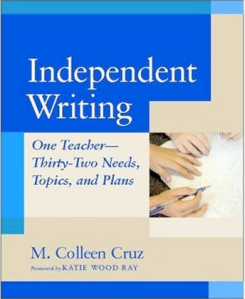Independent Writing: One Teacher - Thirty-Two Needs, Topics, and Plans (Colleen Cruz): A Book Review
Two student statements resonate with me like fingernails down a chalkboard: I don't have anything to write about and I'm done. In Independent Writing, Colleen Cruz argues that students need to learn to write independently as much as they need to learn both the writing process and the objectives of teacher-directed mini-lessons.
Cruz emphasizes three major components of student writing independence:
- Identification and use of mentors and mentor texts,
- personal choice in the use of writer's notebooks, and
- responsible participation in a writing community.
Finding and Using Mentors
Colleen Cruz uses the term mentors in a variety of ways. Commercially published authors can be mentors. Individual texts can serve as mentors. Classmates mentor other classmates.
Cruz outlines mini-lessons that help students choose a mentor text and use a mentor text. To help students who struggle to find appropriate mentor texts, Cruz carries a folder of photocopied writing that may be applied to multiple student needs. Students are explicitly taught to read from a writer's perspective, analyzing choices that authors make and applying similar techniques to their own pieces.
While not explicitly stated, the use of mentor texts aligns with Robert Marzano's suggested strategy of Identifying Similarities and Differences. Cruz's suggestions might be supplemented with a review of Classroom Instruction that Works: Research-Based Strategies for Inc....
Personalizing Writers' Notebooks
Cruz argues that many students view the Writer's Notebook as something students keep to fulfill teacher requirements at school. She cleverly shows students a regular writing notebook that she uses in class alongside a "secret writing notebook" that she carries in her purse. This lesson emphasizes to students that writing notebooks can serve a variety of purposes. One notebook might be used solely for a large project. Another might contain notes, observations, and lists. Students are encouraged to manage multiple notebooks for individual purposes.
By analyzing their own notebooks, students articulate their pre-writing and drafting styles as they progress through the writing process. Some may write lists, sketches, and outlines. Others may handwrite full drafts or write checklists in the margins. Cruz also suggests students analyze famous authors' uses of notebooks as detailed in Speaking of Journals.
Becoming Part of a Writing Community
In her chapter about building a community of writers, Colleen Cruz discusses various types of student groupings. A class is described as a colony of writers. A salon is described as a permanent or semi-permanent group of six to eight student writers. A writing club is a temporary grouping focused on solving a particular topic or problem. Partnerships may be temporary or year-long. New to me was the idea of seminars, where groups of three to eight students ask the teacher to give a specific lesson on a particular topic. After the seminars, students leave with new information and new mentor texts that help them address their particular needs.Cruz believes that these groupings should be chosen and organized by students themselves. She specifies procedures that help group formations run smoothly. She suggests specific mini-lessons that facilitate productive student to student conversation. Also, Cruz mentions that students may lead seminars.
Personal Reflection
I was happy to see how Colleen's mini-lessons are built off the Columbia Teachers College Reading and Writing Project and lessons from Lucy Calkins's materials. Colleen Cruz worked with leaders at the Reading and Writing Project to refine her practice in a way that covered state-mandated curriculum and also facilitated student choice in writing. Not only am I familiar with the Columbia Teachers College philosophy and Calkins's books, my school has adopted Lucy Calkins materials as the primary curricular resource for writing instruction.
The additional student independence adds to my current writing instruction in two potentially powerful ways:
- Students are able to manage multiple projects at once. Rather than doodling or finding distractions while waiting for me to help them with essays or stories, students can re-engage in their independent projects.
- Students learn more about themselves as writers. As they explore preferred genres and formats, they are able to identify strengths and weaknesses that would not be apparent through traditional units of study.
I like how Colleen Cruz emphasizes that teachers need to help students think of what their piece is about (the content) before thinking about the format of presentation. The content must be worthy of the presentation.
If I could add something to this book, I would address the use of technology in writing instruction. I found myself making margin notes about ways classroom management could be enhanced with the use of Interactive White Boards, Google Calendars, online resource lists, and the creation of webinars. I thought about ways Folderboy.com might be used for the brainstorming of ideas, learning logs might document the writing process, and a classroom blog might publicize final projects. I will explore these ideas in future posts.
In Independent Writing, Colleen Cruz discloses her frustrations when students continue to struggle with things to write about. She admits that some students will never love writing, but that student choice makes the writing process palatable for ever-reluctant writers. Hence, while students may still say I don't know what to write about, they will be far less likely to say, I'm done.
Comment
© 2024 Created by Steve Hargadon.
Powered by
![]()

You need to be a member of Classroom 2.0 to add comments!
Join Classroom 2.0